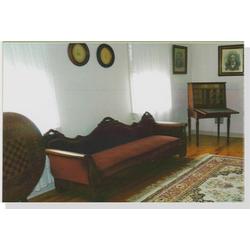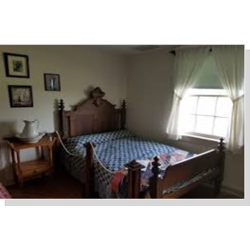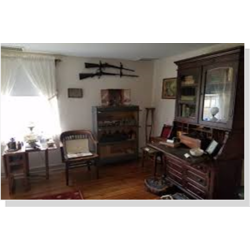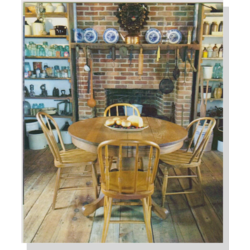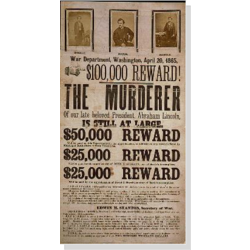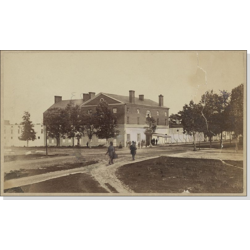
Dr. Samuel Mudd — 1833-1883
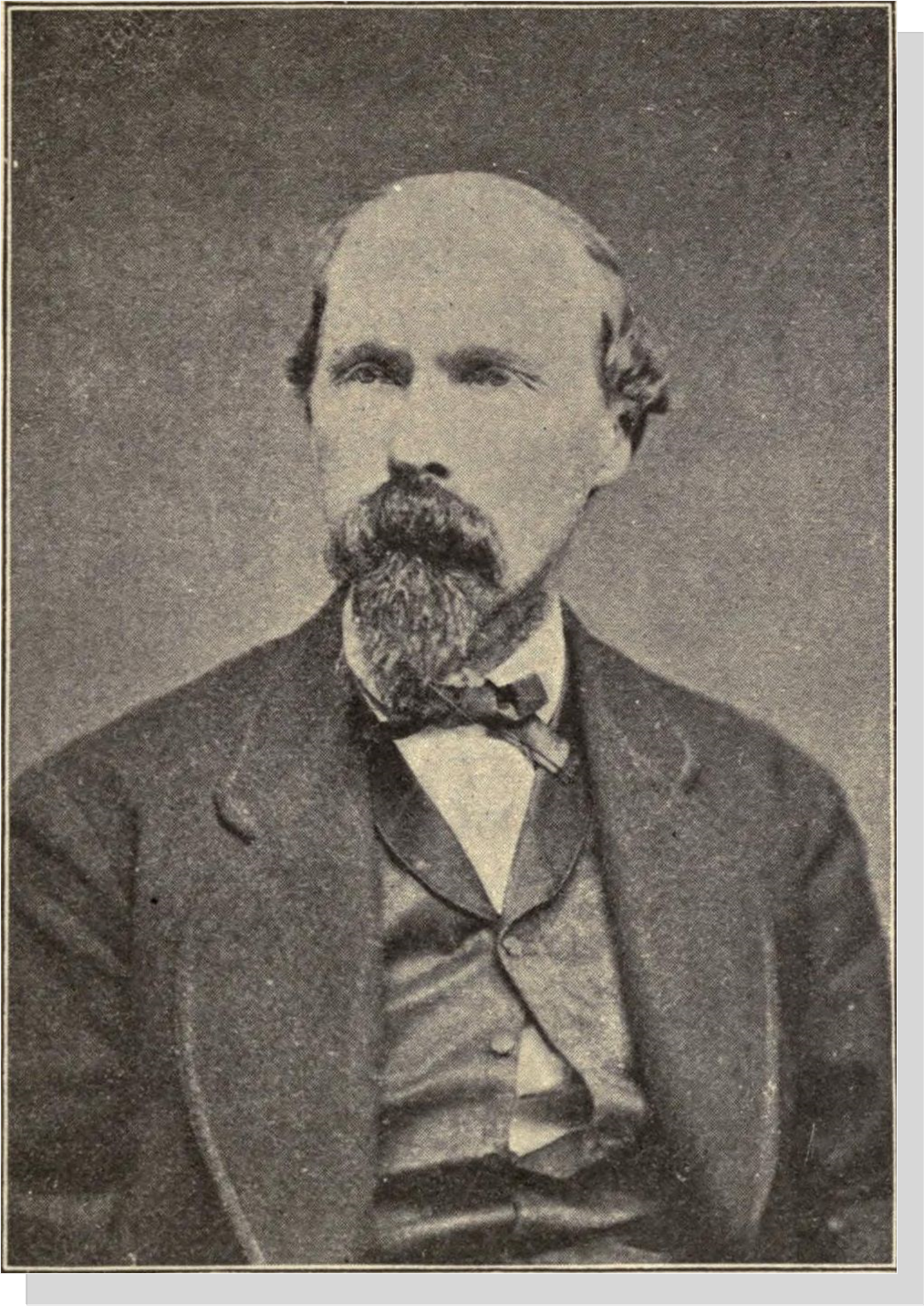
John Wilkes Booth — 1838-April 26, 1865
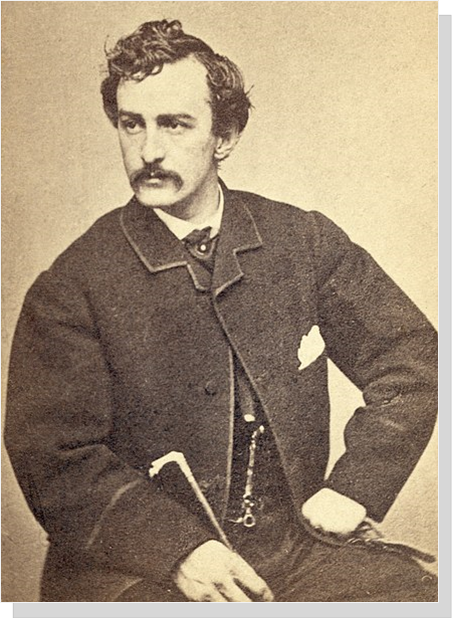
(Copyright © 2012 Annandale Chamber of Commerce. All rights reserved. (Photographs & images, on this page, and on this website, are not available for use by other publications, blogs, individuals, websites, or social media sites.) Photographs are from Wikipedia, the author, The Library of Congress, the National Archives, or courtesy of the Dr. Samuel Mudd House Museum.
Dr. Mudd's House & Museum
Explore Local History
By: M. Callahan
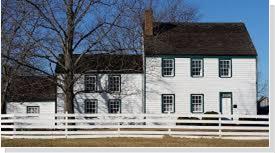 Dr. Mudd’s 19th century farmhouse in Waldorf, MD became an historic site when president Abraham Lincoln was assassinated by John Wilkes Booth. At Dr. Mudd’s, Booth received medical treatment for a broken fibula received when Booth jumped from the President’s theatre box to the stage at Ford’s Theatre in Washington. Booth had just shot the President..
Dr. Mudd’s 19th century farmhouse in Waldorf, MD became an historic site when president Abraham Lincoln was assassinated by John Wilkes Booth. At Dr. Mudd’s, Booth received medical treatment for a broken fibula received when Booth jumped from the President’s theatre box to the stage at Ford’s Theatre in Washington. Booth had just shot the President..
This farmhouse is cozy and bright, and very typical of farmhouse architecture of the mid 19th century. The house features wide plank floors, small bedrooms with multiple beds, fireplaces in each room, well lit from multiple windows and white painted walls. Empire furnishings of fine craftsmanship and an impressive array of tableware and accoutrements adorn a gracious dining room table and sideboards. In the parlor, many Mudd family antiques remain including the sofa where Booth’s broken leg was examined.
Only a fifty minute drive brings you to this historic site and a rather fascinating tour. Docents, in period dress, provide a thorough and friendly tour of both floors and a captivating 1860’s kitchen filled with period pots, jars, utensils, cooking stoves and fires. This kitchen equipment was characteristic of the time and had been in use for centuries but only remained operational for another 50 years. After electricity reached the rural communities kitchens changed forever.
According to the museum’s literature, Samuel Alexander Mudd was born December 20, 1833, in Charles County, Maryland, the fourth of the ten children of Henry Lowe Mudd and his wife, Sarah Ann Reeves. Mudd was raised on the family plantation “Oak Hill,” approximately 30 miles from downtown Washington, D.C., and received his early education in Frederick, MD where he attended St. John’s College for two years. On September 16, 1851, he entered Georgetown College and three years later enrolled as a student at the University of Maryland Medical Department from which he graduated.
After graduation, the young doctor married his childhood sweetheart, Sarah Frances Dyer (whom he called “Frank” for the reason that he already had a sister with a similar name) on Thanksgiving Day, November 26, 1857. They eventually became the parents of nine children and grandparents of 33 grandchildren.
About the time of his marriage, Sam’s father gave the plantation St. Catharine, containing 218 acres to his son. It is one of the few plantations in the State of Maryland that has remained in the same family for more than two centuries.
St. Catharine was originally part of the Oak Hill plantation, owned by Thomas Mudd who came to American during the 1640s. The farm mainly produced tobacco with the servitude provided by ten slaves, most of whom lived in quarters located on the crest of the hill adjacent to the path designated as the Booth Escape Route. The kitchen was changed in 1864, when Dr. Mudd purchased a cook stove to convert from open-hearth cooking. This is one of the most interesting parts of the house.
Mudd was a 31-year-old country doctor, and the father of four children (Andrew, Lillian, Thomas, and Samuel A. Mudd, II), when President Lincoln was assassinated on Good Friday, April 14th, 1865. The assassin, actor John Wilkes Booth, accompanied on horseback by David Herold, arrived at Dr. Mudd’s home at 4 a.m., April 15th. Mudd splinted the broken limb, gave him a shoe to wear, arranged for a carpenter, John Best, to make a pair of crutches, and let the travelers rest for several hours in an upstairs bedroom before continuing their journey later that afternoon. Dr. Mudd was paid $25 in greenbacks for his services.
Leaving by way of a dirt road, Booth and Herold proceeded to Samuel Cox’s house in Bel Alton, Maryland, arriving later that same evening. On April 21st they crossed the river to Virginia and made their way to the Garrett farm near Bowling Green. In the early morning hours of April 26th, two weeks after the assassination, Union cavalry surrounded a tobacco shed where Booth was sleeping. They set fire to the shed. Booth was shot while trying to escape the flames and died on the Garrett front porch.
Mudd living in a strongly sympathetic Confederate community and personally supporting the Confederate cause, had met Booth on multiple occasions. At trail, Mudd claimed that Booth was in disguise and not recognized by him. He also claimed that he did not learn of the president’s assassination until after Booth had departed his home. Yet, at no time did he approach the authorities to report that two individuals (known or strangers) had suddenly appeared at his home in the wee hours following the assassination. His story was not credible and kept changing.
Arrested, tried, and convicted by a military court, Dr. Mudd was sentenced June 29, 1865 to life in prison at Fort Jefferson in the Dry Tortugas off the Florida coast.
During a yellow fever epidemic two years later, Mudd provided medical care for prisoners and guards alike since all of the military doctors had died of the disease. Mudd was pardoned for his tireless medical service and released by Pres. Andrew Johnson on Feb. 8, 1869. After returning home, he fathered another five children, but died young at age 49 on January 10, 1883. Dr. Mudd never fully recovering his health after the years in prison and bout with yellow fever. His wife lived on until Dec. 29, 1911.
This farmhouse was listed on the National Register of Historic Places in 1974. Picnic tables are plentiful on the back lawn for individual or group visitors. There is also plenty of space for the young ones to run off energy before the return ride home.
Dr. Samuel J. Mudd: President Abraham Lincoln's future assassin, John Wilkes Booth, visited Bryantown, Maryland, in November and December 1864, claiming to look for real estate investments. Bryantown is about 25 miles from Washington, DC, and about 5 miles from Mudd's farm. The real estate story was merely a cover; Booth's true purpose was to plan an escape route as part of a plan to kidnap Lincoln. Booth believed the federal government would ransom Lincoln by releasing a large number of Confederate prisoners of war.
Booth met Mudd at St. Mary's Catholic Church in Bryantown during one of those visits, probably in November. Booth visited Mudd at his farm the next day, and stayed there overnight. The following day, Booth purchased a horse from Mudd's neighbor and returned to Washington. It is believed that Booth used his visit to Bryantown to recruit Mudd to his kidnapping plot.
A short time later, on December 23, 1864, Mudd went to Washington where he met Booth again. The two men, as well as John Surratt, Jr., and Louis J. Weichmann, had a conversation and drinks together, first at Booth's hotel and later at Mudd's.
According to a statement made by associated conspirator George Atzerodt, found long after his death and taken down while he was in federal custody in May 1865, Mudd knew in advance about Booth's plans; Atzerodt was sure the doctor knew, he said, because Booth had "sent (as he told me) liquors & provisions... about two weeks before the murder to Dr. Mudd's." It is possible that Mudd was involved in a completely different conspiracy for the southern states. Prior to the assassination of Lincoln, Booth originally intended to kidnap the president and hold him and other political affiliates of the Union for a large sum of money. The plan was in effect until the night of the assassination, when Booth met up with Atzerodt, David Herold and Lewis Powell. When Atzerodt was arrested at Mary Surratt's house days after the murder, he disclosed the plot to assassinate the president. Following the assassination, Powell came forth by stating that Booth had not told him until the meeting and that the other men did not know about the plot until the night of the assassination. That supports the theory that Mudd may have been an accomplice to the plot to kidnap the president but not a conspirator to the assassination.
After Booth shot Lincoln he met up with Herold and both made for Virginia, via southern Maryland. They stopped at Mudd's house around 4 a.m. on April 15. He and Herold spent between twelve and fifteen hours at Mudd's house and slept in the front bedroom on the second floor. It is unclear whether Mudd had yet been informed that Booth had killed Lincoln.
Mudd went to Bryantown during the day on April 15 to run errands; if he did not already know the assassination news from Booth, he certainly learned of it on this trip. Mudd returned home that evening with differing accounts later emerging as to whether Booth and Herold had already left, whether Mudd met them as they were leaving, or whether they left at Mudd's urging and with his assistance.
It is certain that Mudd did not immediately contact the authorities. When questioned, he stated that he had not wanted to leave his family alone in the house in case the assassins returned and found him absent and his family unprotected. He waited until Mass the following day, Easter Sunday, when he asked his second cousin, Dr. George Mudd, a resident of Bryantown, to notify the 13th New York Cavalry in Bryantown, under the command of Lieutenant David Dana. The delay in contacting the authorities drew suspicion and was a significant factor in tying Mudd to the conspiracy.
During his initial investigative interview on April 18, Mudd stated that he had never seen either of the parties before. In his sworn statement, he told about Booth's visit to Bryantown in November 1864 but then said, "I have never seen Booth since that time to my knowledge until last Saturday morning." He hid his meeting with Booth in Washington in December 1864. In prison, Mudd admitted the Washington meeting and said he ran into Booth by chance during a Christmas shopping trip. Mudd's failure to mention the meeting in his interview with detectives was a big mistake. When Weichmann later told the authorities of the meeting, they realized that Mudd had misled them and immediately began to treat him as a suspect, rather than a witness.
During the conspiracy trial, Lieutenant Alexander Lovett testified, "On Friday, the 21st of April, I went to Mudd's again, for the purpose of arresting him. When he found we were going to search the house, he said something to his wife, and she went upstairs and brought down a boot. Mudd said he had cut it off the man's leg. I turned down the top of the boot, and saw the name 'J. Wilkes' written in it."
Fort Lesley J. McNair was established in 1791 and, at that time, considered a major site and arsenal for the defense of the capital. The first federal penitentiary was established in 1826 on land in the northern portion of the site. The four conspirators accused of assassinating President Abraham Lincoln were imprisoned, tried and executed at this site then known as the Washington Arsenal.
Mary Elizabeth Jenkins Surratt (1820 or May 1823 – July 7, 1865) was an American boarding house owner who was convicted of taking part in the conspiracy to assassinate U.S. President Abraham Lincoln. She was the first woman executed by the US federal government. Surratt was the mother of John Surratt (Jr.) who was later tried but not convicted of involvement in the assassination. John Surratt, Jr. was a Confederate courier and close friend of the actual assassin, John Wilkes Booth.
Executed by hanging July 7, 1865. Buried in shallow graves against the
prison wall a few feet from the gallows. Mary was reinterned at Mount
Olivet Cemetery, MD in 1869.
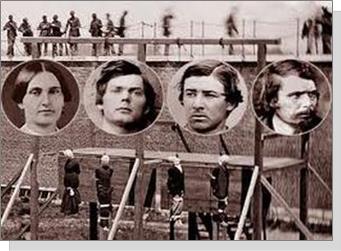 The four convicted conspirators are executed & initially buried
The four convicted conspirators are executed & initially buried
by the back wall of the prison on July 7, 1865.
Mary Surratt: Conspirators met at her boarding house and kept a cache of arms at her tavern in what is now Clinton, MD.
Lewis Powell: Attempted to assassinate Sect. State Wm. Seward. Stabbed him multiple times but did not kill him.
David Herold: Accompanied Booth in escape from DC & to Mudd’s House for medical care. Picked up cache of arms left for them by Mary at the Surratt Tavern.
George Atzerodt: Assigned to kill VP Andrew Johnson. Did not make the attempt
Information contained in this article is from interviews, personal tours, and from the Dr. Samuel Mudd House Museum staff and foundation.
Reproduction of this article or photographs requires the written permission of the author and The ENDEAVOR News Magazine. Photographs are courtesy of the author with all right of use reserved. (Copyright © 2012 Annandale Chamber of Commerce. All rights reserved. (Photographs & images, on this page, and on this website, are not available for use by other publications, blogs, individuals, websites, or social media sites.)
Copyright 2012 Annandale Chamber of Commerce. All rights reserved. Privacy Policy

